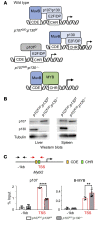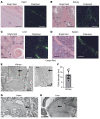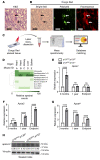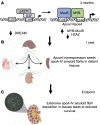Disrupting the DREAM transcriptional repressor complex induces apolipoprotein overexpression and systemic amyloidosis in mice
- PMID: 33444292
- PMCID: PMC7880409
- DOI: 10.1172/JCI140903
Disrupting the DREAM transcriptional repressor complex induces apolipoprotein overexpression and systemic amyloidosis in mice
Abstract
DREAM (Dp, Rb-like, E2F, and MuvB) is a transcriptional repressor complex that regulates cell proliferation, and its loss causes neonatal lethality in mice. To investigate DREAM function in adult mice, we used an assembly-defective p107 protein and conditional deletion of its redundant family member p130. In the absence of DREAM assembly, mice displayed shortened survival characterized by systemic amyloidosis but no evidence of excessive cellular proliferation. Amyloid deposits were found in the heart, liver, spleen, and kidneys but not the brain or bone marrow. Using laser-capture microdissection followed by mass spectrometry, we identified apolipoproteins as the most abundant components of amyloids. Intriguingly, apoA-IV was the most detected amyloidogenic protein in amyloid deposits, suggesting apoA-IV amyloidosis (AApoAIV). AApoAIV is a recently described form, whereby WT apoA-IV has been shown to predominate in amyloid plaques. We determined by ChIP that DREAM directly regulated Apoa4 and that the histone variant H2AZ was reduced from the Apoa4 gene body in DREAM's absence, leading to overexpression. Collectively, we describe a mechanism by which epigenetic misregulation causes apolipoprotein overexpression and amyloidosis, potentially explaining the origins of nongenetic amyloid subtypes.
Keywords: Epigenetics; Lipoproteins; Mouse models; Nephrology; Vascular Biology.
Conflict of interest statement
Figures







Similar articles
-
Loss of the Caenorhabditis elegans pocket protein LIN-35 reveals MuvB's innate function as the repressor of DREAM target genes.PLoS Genet. 2017 Nov 1;13(11):e1007088. doi: 10.1371/journal.pgen.1007088. eCollection 2017 Nov. PLoS Genet. 2017. PMID: 29091720 Free PMC article.
-
Clinical, biopsy, and mass spectrometry characteristics of renal apolipoprotein A-IV amyloidosis.Kidney Int. 2016 Sep;90(3):658-64. doi: 10.1016/j.kint.2016.04.003. Epub 2016 Jun 2. Kidney Int. 2016. PMID: 27262366
-
DREAM interrupted: severing LIN-35-MuvB association in Caenorhabditis elegans impairs DREAM function but not its chromatin localization.Genetics. 2022 Jul 4;221(3):iyac073. doi: 10.1093/genetics/iyac073. Genetics. 2022. PMID: 35554539 Free PMC article.
-
Systemic Amyloidosis Due to Clonal Plasma Cell Diseases.Hematol Oncol Clin North Am. 2020 Dec;34(6):1009-1026. doi: 10.1016/j.hoc.2020.08.001. Epub 2020 Sep 28. Hematol Oncol Clin North Am. 2020. PMID: 33099420 Review.
-
Successes in translation.Amyloid. 2024 Sep;31(3):159-167. doi: 10.1080/13506129.2024.2387163. Epub 2024 Aug 5. Amyloid. 2024. PMID: 39101820 Review.
Cited by
-
RBL1/p107 Expression Levels Are Modulated by Multiple Signaling Pathways.Cancers (Basel). 2021 Oct 8;13(19):5025. doi: 10.3390/cancers13195025. Cancers (Basel). 2021. PMID: 34638509 Free PMC article.
-
Bioinformatic identification and experiment validation reveal 6 hub genes, promising diagnostic and therapeutic targets for Alzheimer's disease.BMC Med Genomics. 2024 Jan 2;17(1):6. doi: 10.1186/s12920-023-01775-6. BMC Med Genomics. 2024. PMID: 38167011 Free PMC article.
-
Amyloid precursor protein as a fibrosis marker in infants with biliary atresia.Pediatr Res. 2025 Apr;97(5):1696-1705. doi: 10.1038/s41390-024-03582-w. Epub 2024 Sep 28. Pediatr Res. 2025. PMID: 39341941 Free PMC article.
-
The Roles of Fatty Acids and Apolipoproteins in the Kidneys.Metabolites. 2022 May 20;12(5):462. doi: 10.3390/metabo12050462. Metabolites. 2022. PMID: 35629966 Free PMC article. Review.
-
Age-related TFEB downregulation in proximal tubules causes systemic metabolic disorders and occasional apolipoprotein A4-related amyloidosis.JCI Insight. 2024 Dec 19;10(3):e184451. doi: 10.1172/jci.insight.184451. JCI Insight. 2024. PMID: 39699959 Free PMC article.
References
-
- Nuvolone M, Merlini G. Systemic amyloidosis: novel therapies and role of biomarkers. Nephrol Dial Transplant. 2017;32(5):770–780. - PubMed
Publication types
MeSH terms
Substances
Grants and funding
LinkOut - more resources
Full Text Sources
Other Literature Sources
Molecular Biology Databases
Miscellaneous

